wheel MITSUBISHI ECLIPSE 1990 Service Manual
[x] Cancel search | Manufacturer: MITSUBISHI, Model Year: 1990, Model line: ECLIPSE, Model: MITSUBISHI ECLIPSE 1990Pages: 391, PDF Size: 15.27 MB
Page 4 of 391
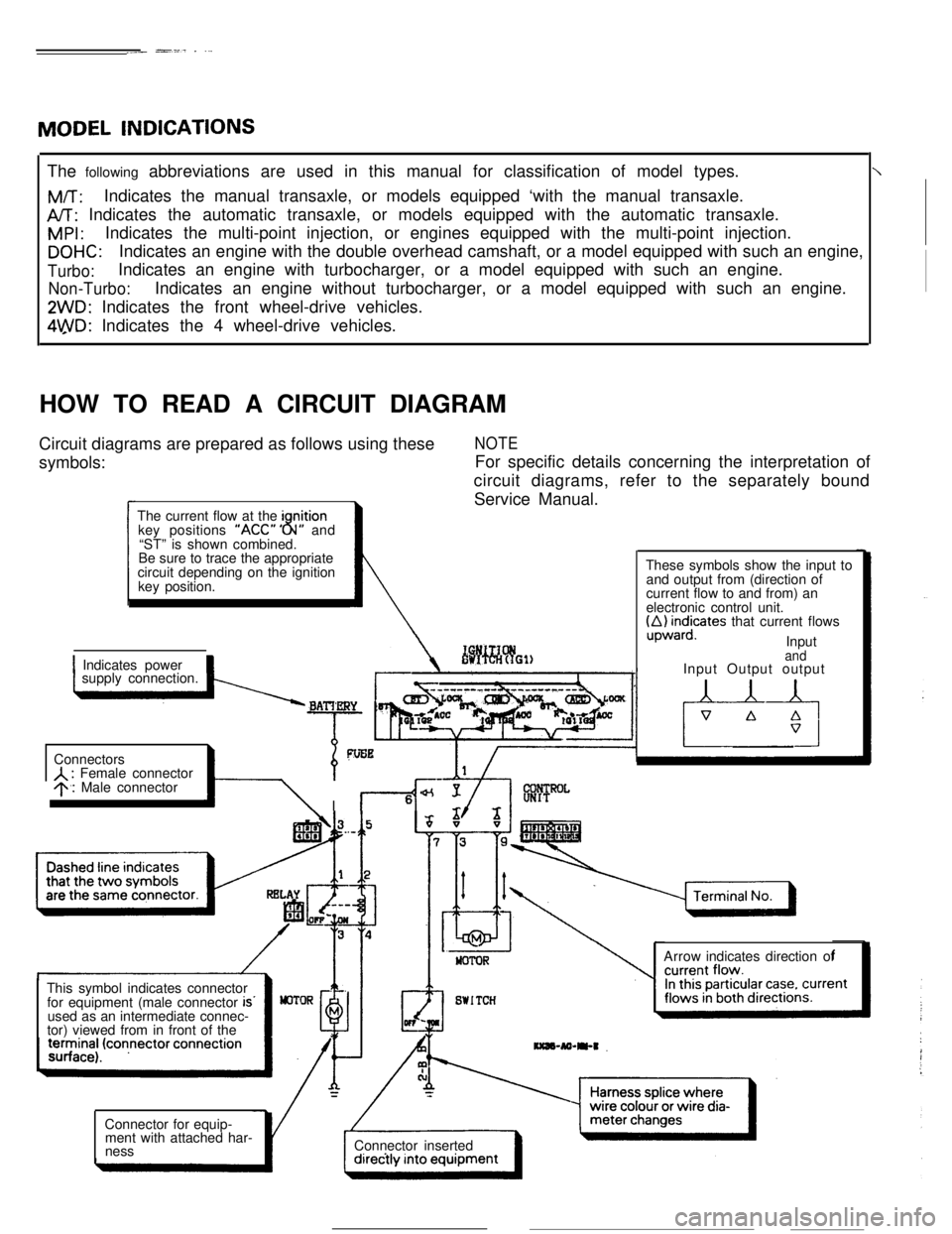
._._ -_- 1 -.
MODEL INDICATIONS
The following abbreviations are used in this manual for classification of model types.\
M/T: Indicates the manual transaxle, or models equipped ‘with the manual t\
ransaxle.
A/T: Indicates the automatic transaxle, or models equipped with the automatic\
transaxle.
MPI: Indicates the multi-point injection, or engines equipped with the multi-\
point injection.
DOHC: Indicates an engine with the double overhead camshaft, or a model equipp\
ed with such an engine,
Turbo: Indicates an engine with turbocharger, or a model equipped with such an \
engine.
2WD: Indicates the front wheel-drive vehicles.
4WD: Indicates the 4 wheel-drive vehicles.
HOW TO READ A CIRCUIT DIAGRAM
initionkey positions “ACC” ” N” and8“ST” is shown combined.
~
Service Manual.
o&ficates that current flows
Input
1 Indicates power1supply connection.
A : Female connector9.1 Male connector
\ Il-4’
Input Output output
is..used as an intermediate connec-
Page 5 of 391
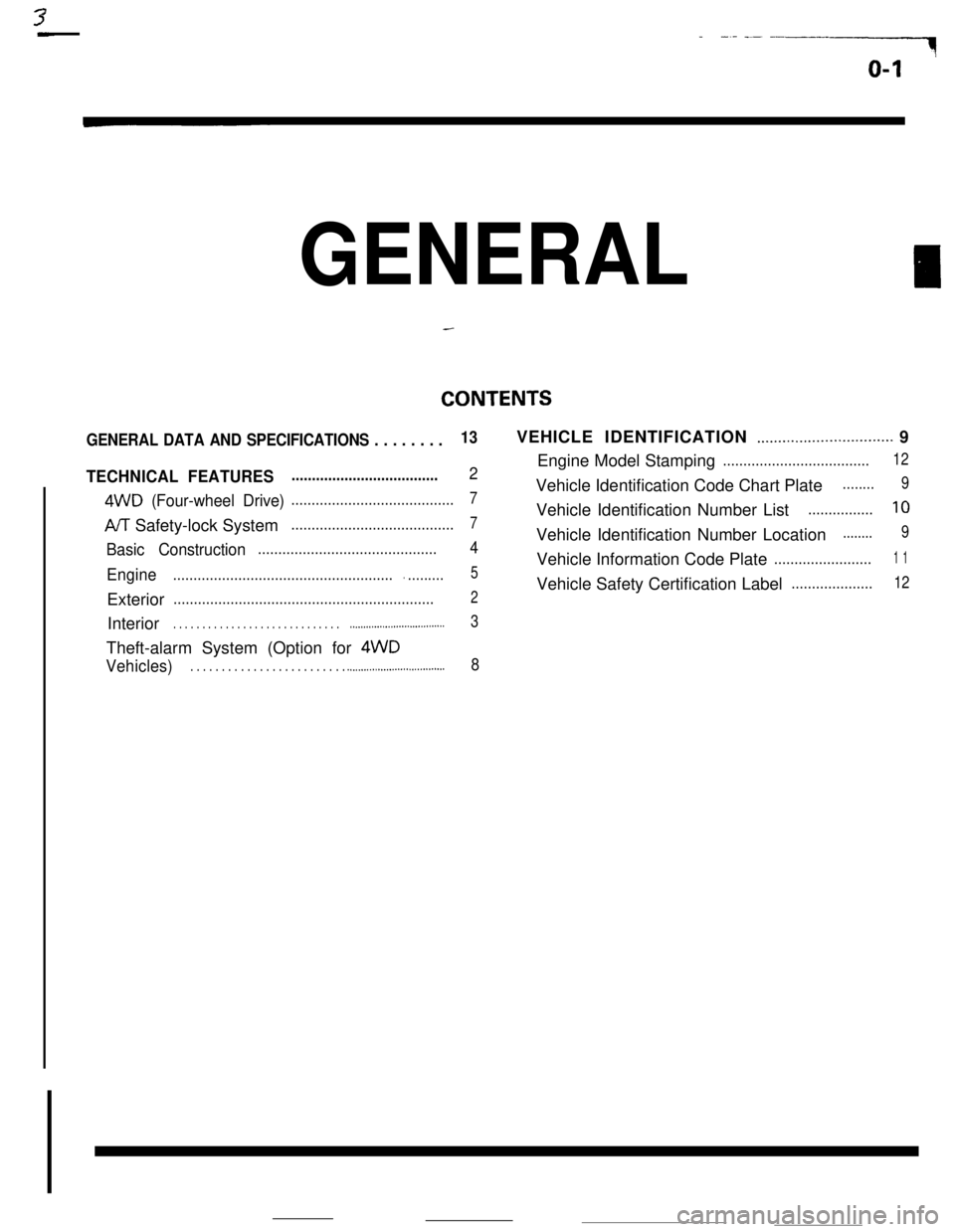
GENERAL
---- -~- -------l
O-l
CONTENTS
GENERAL DATA AND SPECIFICATIONS . . . . . . . ..._..................._........_ 9
TECHNICAL FEATURES
4WD (Four-wheel Drive)........................................710
PJT Safety-lock Syste m........................................7
..__............................... 3
Theft-alarm System (Option for 4WD
Vehicles) . . . . . . . . . . . . . . . . . . . . . . . . . .._._........_..................... 8
Page 8 of 391
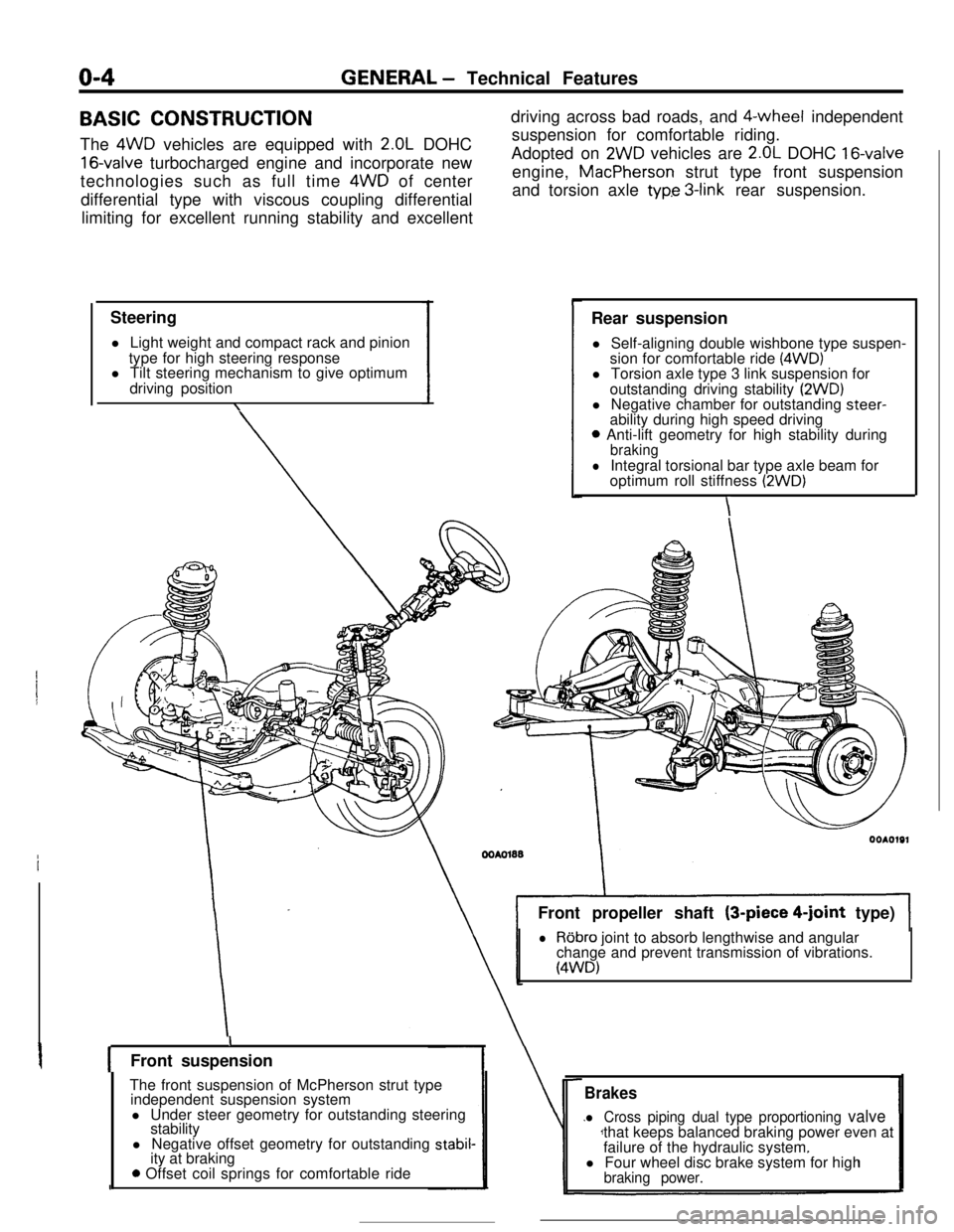
o-4GENERAL - Technical Features
BASIC CONSTRUCTION
The 4WD vehicles are equipped with
2.OL DOHC
16-valve turbocharged engine and incorporate new
technologies such as full time 4WD of center
differential type with viscous coupling differential
limiting for excellent running stability and excellent
Steering
l Light weight and compact rack and pinion
type for high steering response
l Tilt steering mechanism to give optimum
driving position
\driving across bad roads, and $-wheel independent
suspension for comfortable riding.
Adopted on
2WD vehicles are 2.OL DOHC 16-valveengine, MacPherson strut type front suspension
and torsion axle
typ.e 3-link rear suspension.
Rear suspension
l Self-aligning double wishbone type suspen-
sion for comfortable ride
(4WD)l Torsion axle type 3 link suspension for
outstanding driving stability
(2WD)l Negative chamber for outstanding steer-
ability during high speed driving
0 Anti-lift geometry for high stability duringbraking
lIntegral torsional bar type axle beam for
optimum roll stiffness (2WD)
\Front propeller shaft (3-piece
4-joint type)
lRobro joint to absorb lengthwise and angular
change and prevent transmission of vibrations.
(4WD)
IFront suspension
The front suspension of McPherson strut type
independent suspension system
l Under steer geometry for outstanding steering
stability
l Negative offset geometry for outstanding
stabil-ity at braking
0 Offset coil springs for comfortable ride
Brakes
l Cross piping dual type proportioning valvethat keeps balanced braking power even at
failure of the hydraulic system.
l Four wheel disc brake system for high
braking power.
Page 9 of 391
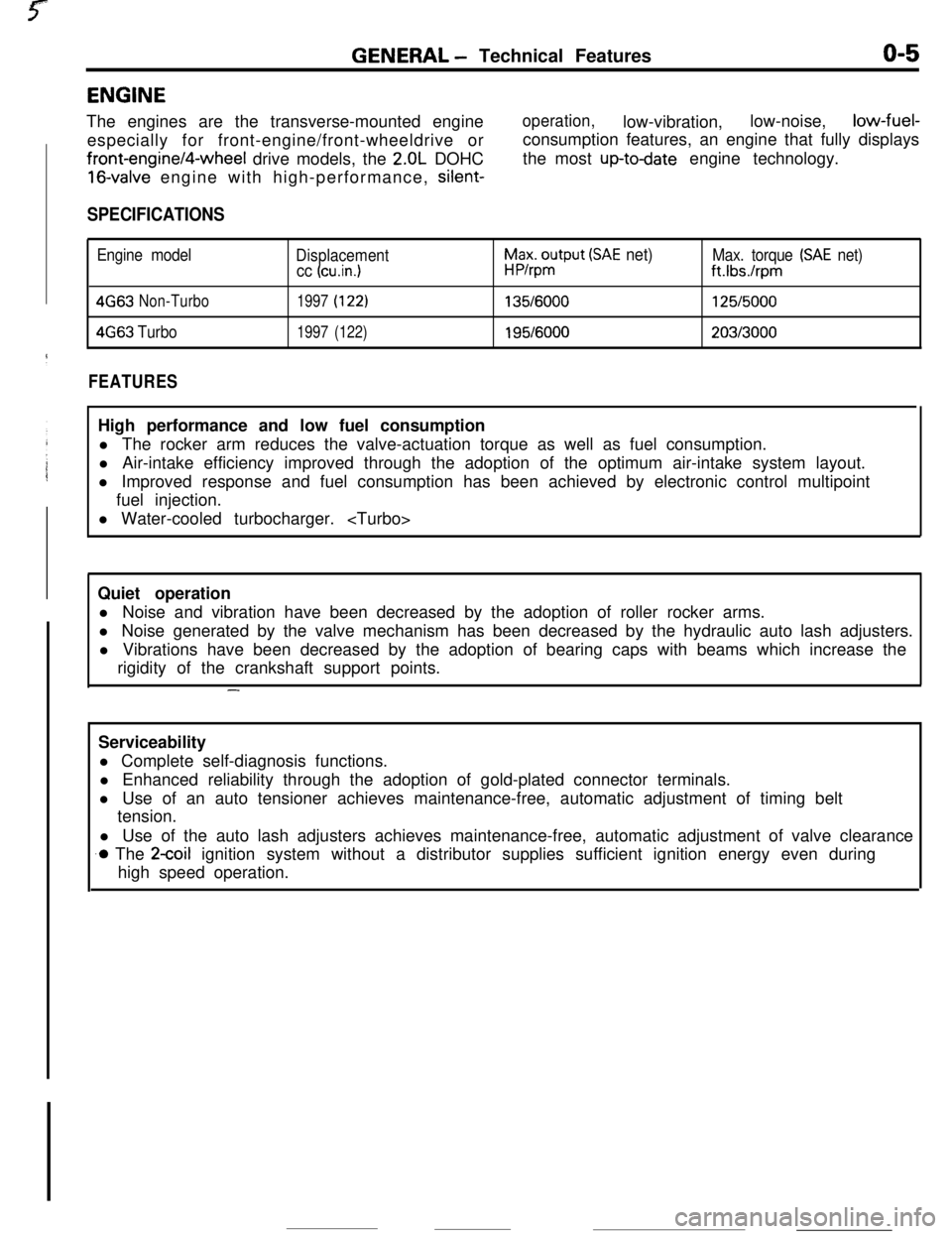
GENERAL - Technical Featureso-5ENGINE
The engines are the transverse-mounted engine
especially for front-engine/front-wheeldrive orfront-engine/4-wheel drive models, the
2.OL DOHC
16-valve engine with high-performance, silent-
operation,low-vibration,low-noise,low-fuel-
consumption features, an engine that fully displays
the most
up-todate engine technology.
SPECIFICATIONS
Engine model
Displacement
cc (cu.in.1
h$xo$put (SAE net)Max. torque (SAE net)
ft.Ibs./rpm
4G63Non-Turbo1997(122)135/6000125/5000
4663Turbo1997(122)195/6000203/3000
FEATURESHigh performance and low fuel consumption
l The rocker arm reduces the valve-actuation torque as well as fuel consumption.
l Air-intake efficiency improved through the adoption of the optimum air-intake system layout.
l Improved response and fuel consumption has been achieved by electronic control multipoint
fuel injection.
l Water-cooled turbocharger.
Quiet operation
l Noise and vibration have been decreased by the adoption of roller rocker arms.
l Noise generated by the valve mechanism has been decreased by the hydraulic auto lash adjusters.
l Vibrations have been decreased by the adoption of bearing caps with beams which increase the
rigidity of the crankshaft support points.
-Serviceability
l Complete self-diagnosis functions.
l Enhanced reliability through the adoption of gold-plated connector terminals.
l Use of an auto tensioner achieves maintenance-free, automatic adjustment of timing belt
tension.
l Use of the auto lash adjusters achieves maintenance-free, automatic adjustment of valve clearance
.o The 2coil ignition system without a distributor supplies sufficient ignition energy even during
high speed operation.
Page 11 of 391
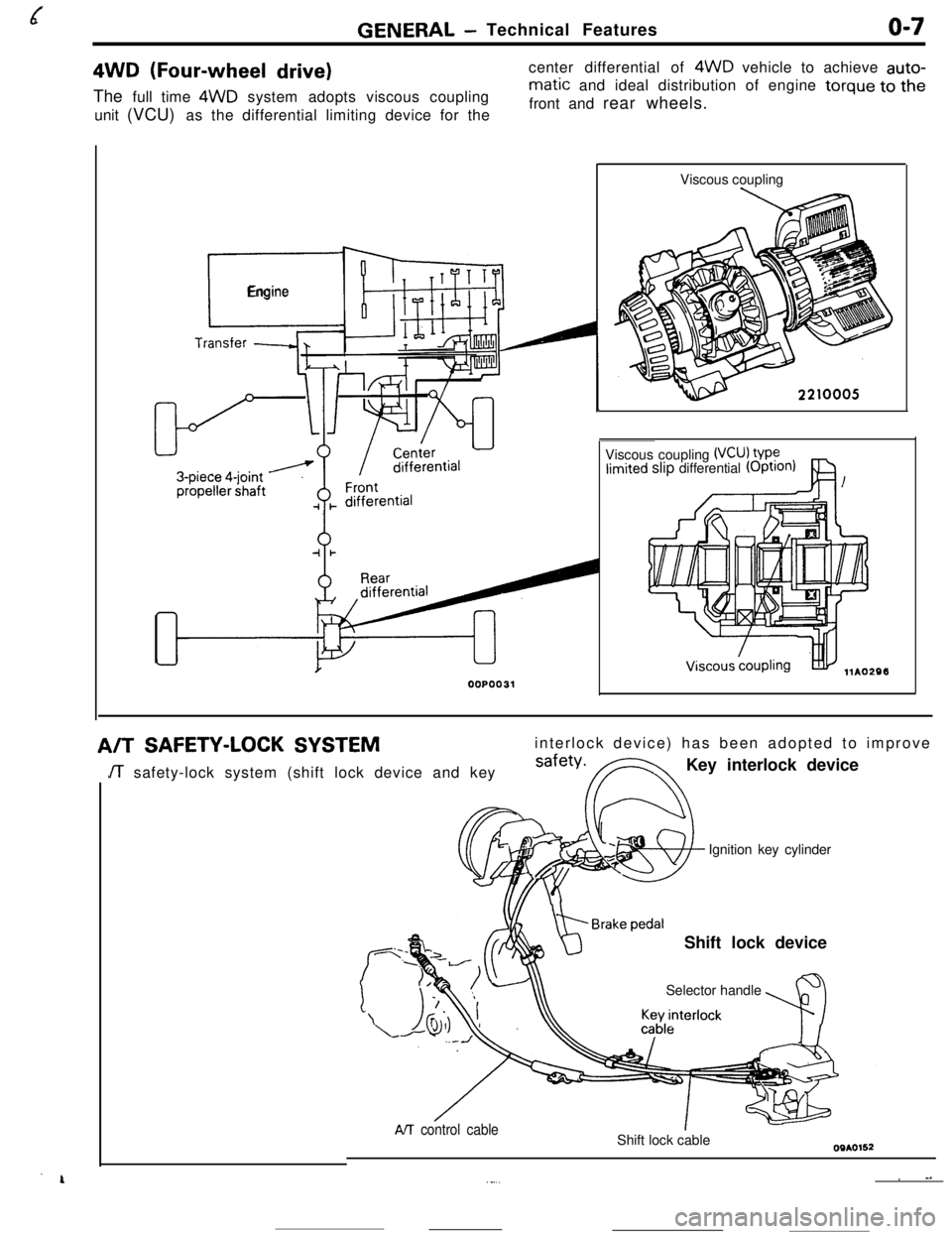
GENERAL -Technical Featureso-74WD
(Four-wheel drive)The full time 4WD system adopts viscous coupling
unit (VCU) as the differential limiting device for thecenter differential of 4WD vehicle to achieve auto-
matic and ideal distribution of engine torque to the
front and rear wheels.
r_
Engine
00P0031Viscous coupling
Viscous coupling
(VCU) VP?limited slip differential (OptIOn)
A/TSAFETY-LOCK SYSTEMinterlock device) has been adopted to improve
JT safety-lock system (shift lock device and keysafety*FNKey interlock device
Ignition key cylinder
Shift lock device
Selector handle
AIT control cableShift lock cable
~ ^.._...
Page 17 of 391
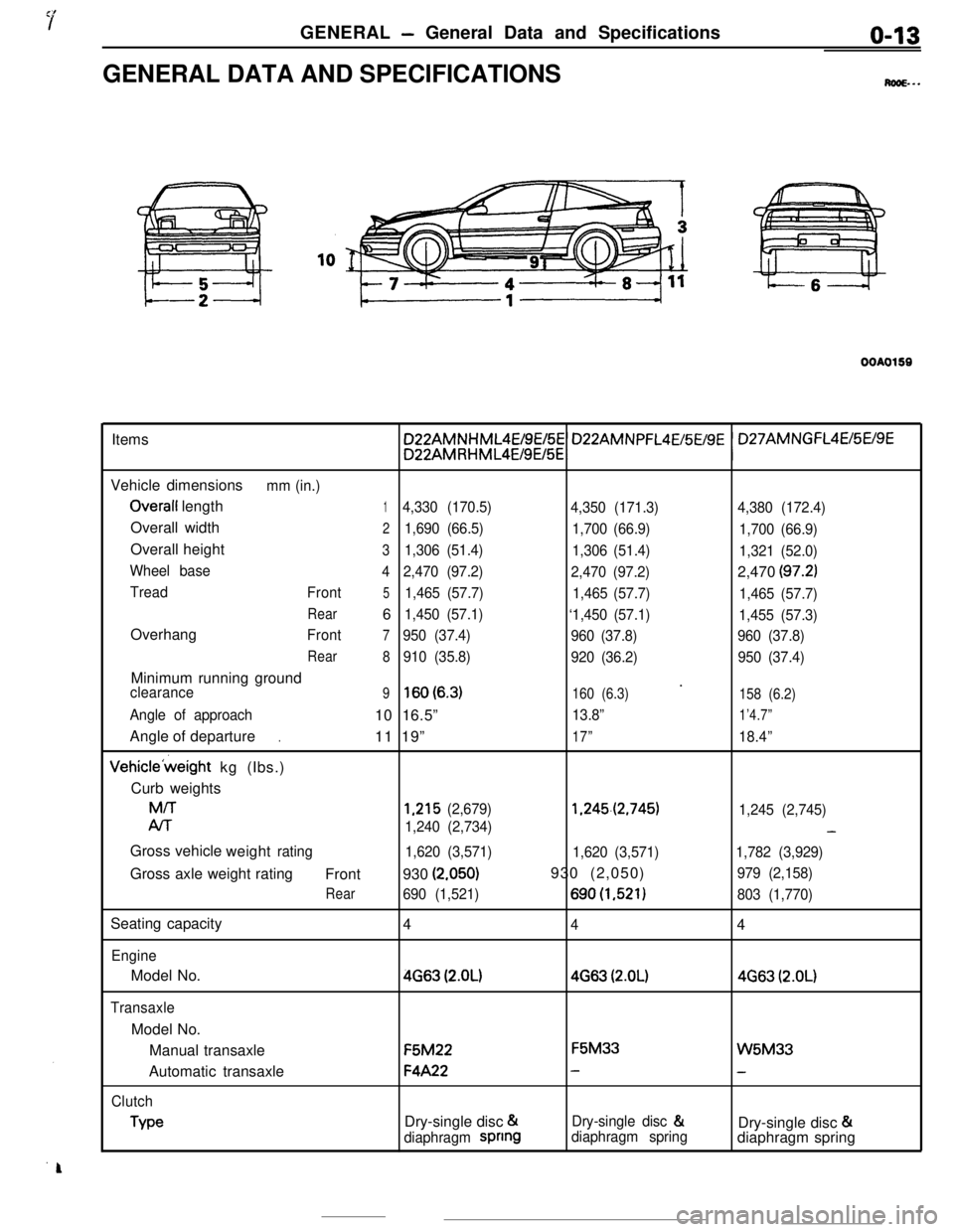
GENERAL - General Data and Specificationso-13GENERAL DATA AND SPECIFICATIONS
M...
OOAO159Items
Vehicle dimensions
mm (in.)
Overall length14,330 (170.5)
4,350 (171.3)4,380 (172.4)Overall width
21,690 (66.5)
1,700 (66.9)
1,700 (66.9)Overall height
31,306 (51.4)
1,306 (51.4)
1,321 (52.0)
Wheel base
42,470 (97.2)
2,470 (97.2)2,470
(97.2)
Tread
Front51,465 (57.7)
1,465 (57.7)
1,465 (57.7)
Rear61,450 (57.1)
‘1,450 (57.1)
1,455 (57.3)Overhang
Front7950 (37.4)
960 (37.8)960 (37.8)
Rear
8910 (35.8)
920 (36.2)950 (37.4)Minimum running ground
’clearance9lsO(6.3)160 (6.3)
158 (6.2)
Angle of approach10 16.5”13.8”1’4.7”Angle of departure
11 19”
17”18.4”.Vehicle’weight kg (Ibs.)
Curb weightsM/T
1,215 (2,679)1.245.(2,745)
1,245 (2,745)
Al-r
1,240 (2,734)-Gross vehicle
weight
rating
1,620 (3,571)
1,620 (3,571)1,782 (3,929)Gross axle weight rating
Front930
(2.050)930 (2,050)979 (2,158)
Rear690 (1,521)690(1,521)803 (1,770)Seating capacity
4
44
EngineModel No.
4663 (2.OL)4663 (2.OL)4663 (2.OL)
TransaxleModel No.
Manual transaxleF5M22F5M33
W5M33Automatic transaxle
F4A22--
Clutch
TypeDry-single disc &Dry-single disc &
Dry-single disc &
diaphragm spnngdiaphragm springdiaphragm spring
Page 26 of 391
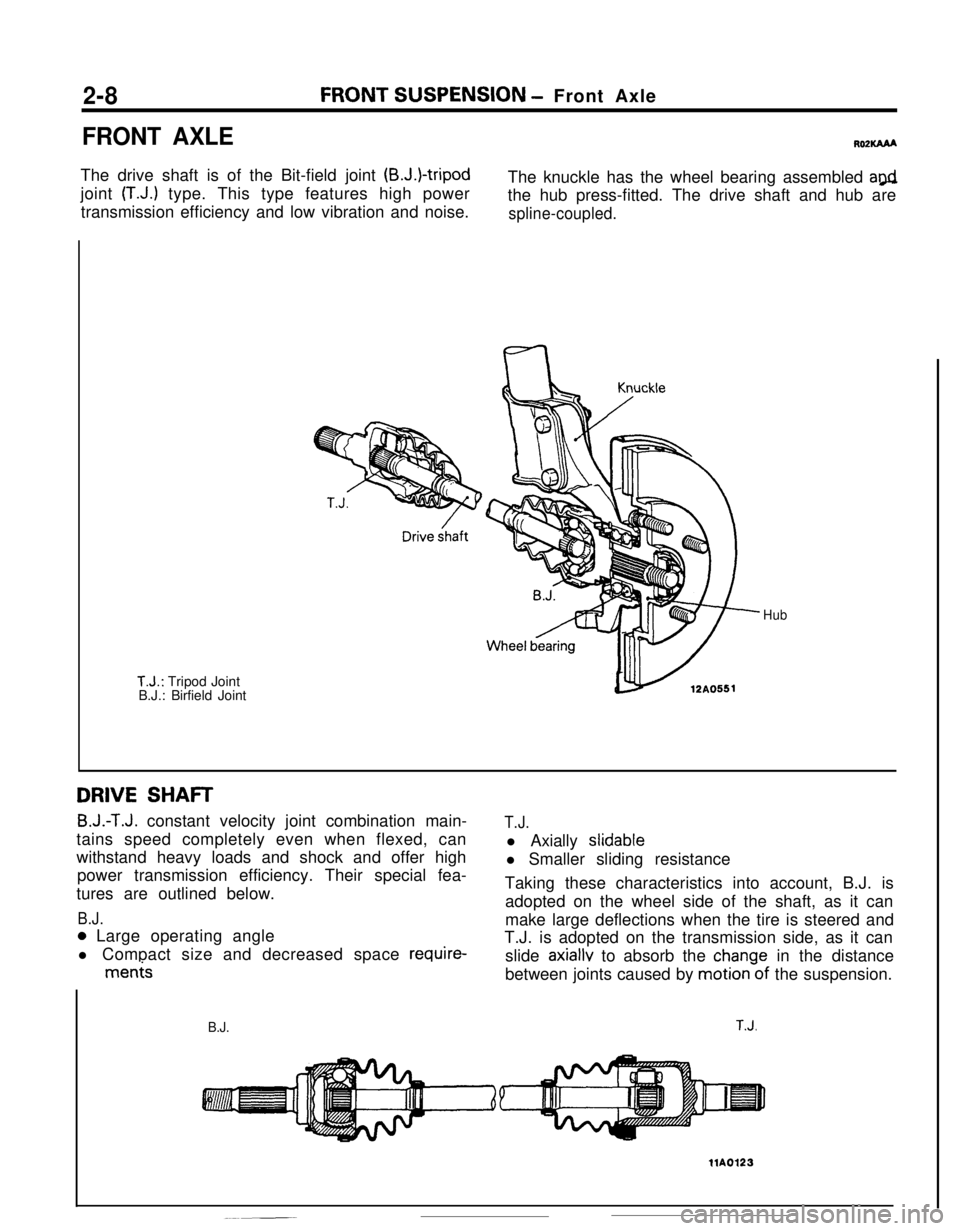
2-8FRONT SUSPENSION - Front Axle
FRONT AXLEROPKAAAThe drive shaft is of the Bit-field joint
(B.J.)-tripodjoint
(T.J.) type. This type features high power
transmission efficiency and low vibration and noise.The knuckle has the wheel bearing assembled
a@the hub press-fitted. The drive shaft and hub are
spline-coupled.
T.J.: Tripod Joint
B.J.: Birfield Joint
Hub
DRIVE SHAFT
B.J.-T.J. constant velocity joint combination main-
tains speed completely even when flexed, can
withstand heavy loads and shock and offer high
power transmission efficiency. Their special fea-
tures are outlined below.
B.J.T.J.l Axially
slidablel Smaller sliding resistance
0 Large operating angle
l Compact size and decreased space
require-
me&Taking these characteristics into account, B.J. is
adopted on the wheel side of the shaft, as it can
make large deflections when the tire is steered and
T.J. is adopted on the transmission side, as it can
slide
axiallv to absorb the chanae in the distance
between joints caused by
motionWof the suspension.
B.J.T.J.
llA0123
Page 27 of 391
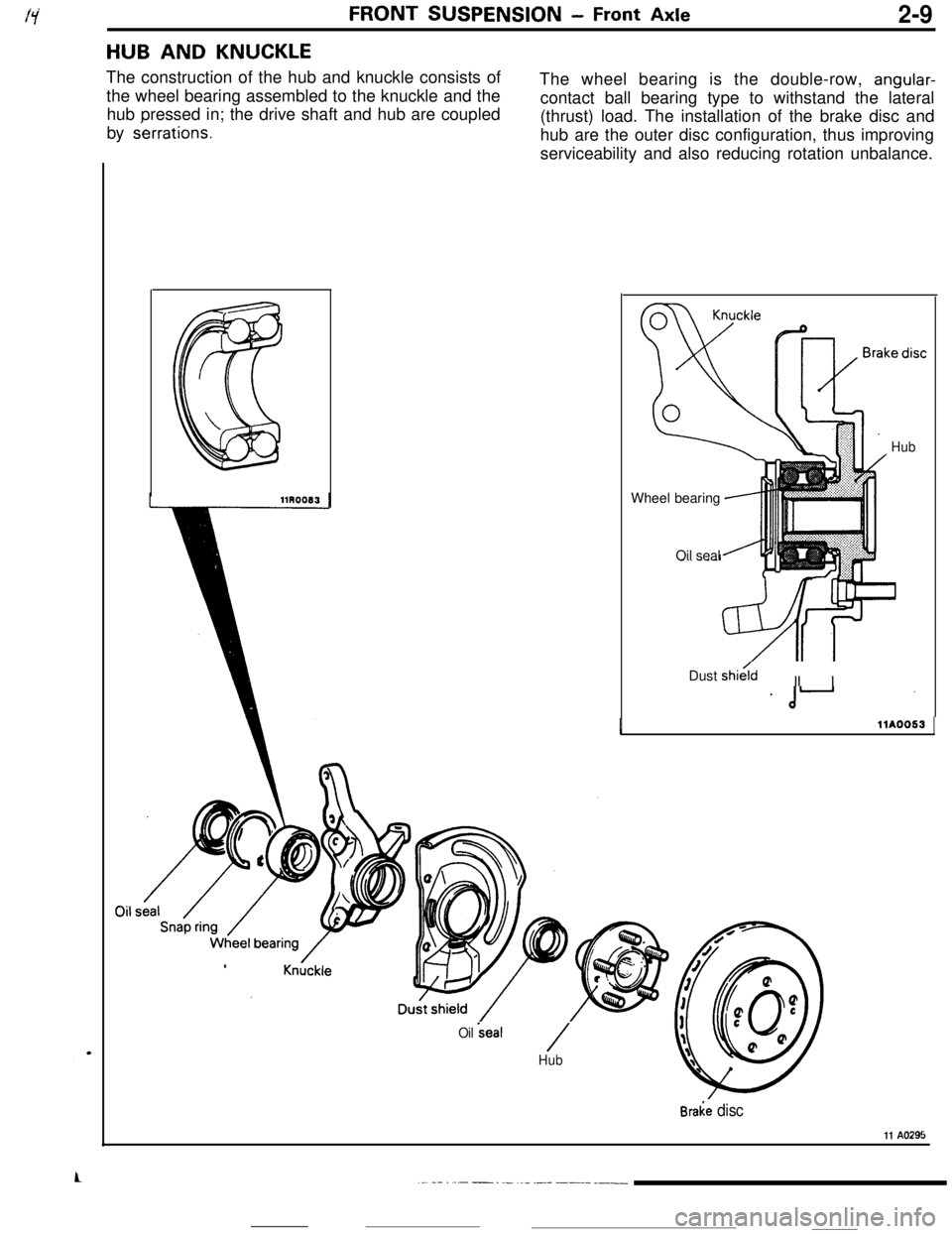
FRONT SUSPENSION - Front Axle2-9
HUB AND KNUCKLEThe construction of the hub and knuckle consists of
The wheel bearing is the double-row,
angular-the wheel bearing assembled to the knuckle and the
contact ball bearing type to withstand the lateral
hub pressed in; the drive shaft and hub are coupled
(thrust) load. The installation of the brake disc and
by
&rations.hub are the outer disc configuration, thus improving
serviceability and also reducing rotation unbalance.
Wheel bearing
Oil seal
HubDust shi&d
II I
IllA0053
Oil seal/HubBraie
disc
11 A0295
..~ -- . ..- - . .._ ~._ __.- ----_ .__
Page 32 of 391
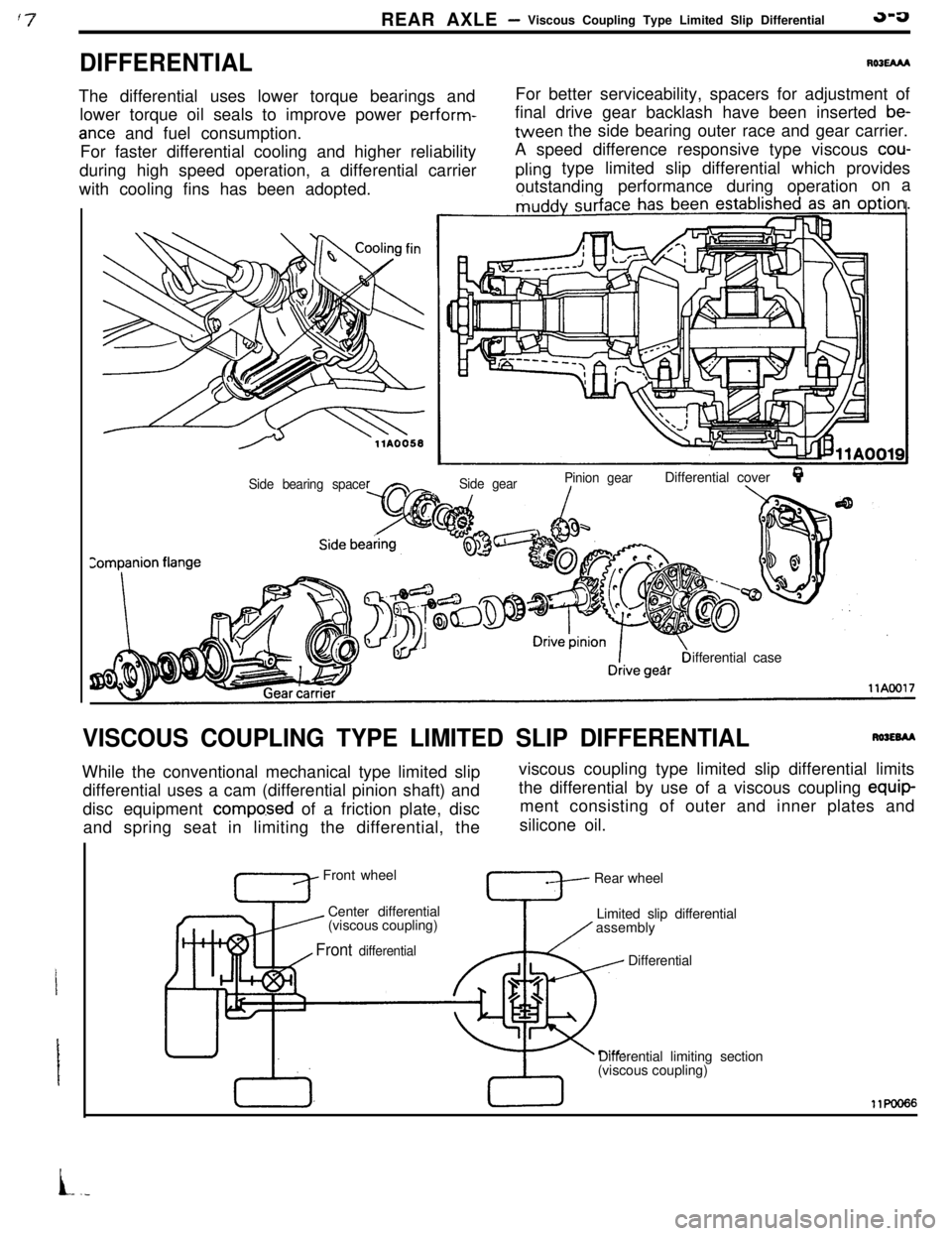
REAR AXLE- Viscous Coupling Type Limited Slip Differential3-a
DIFFERENTIALROlEAM
The differential uses lower torque bearings and
lower torque oil seals to improve power perform-
ante and fuel consumption.
For faster differential cooling and higher reliability
during high speed operation, a differential carrier
with cooling fins has been adopted.For better serviceability, spacers for adjustment of
final drive gear backlash have been inserted
be-tween the side bearing outer race and gear carrier.
A speed difference responsive type viscous
cou-
pling type limited slip differential which provides
outstandingperformance during operationon a
Side gearPinion gearDifferential coverQ./\Side bearing spaceifferential case
VISCOUS COUPLING TYPE LIMITED SLIP DIFFERENTIALRWEBAAWhile the conventional mechanical type limited slip
differential uses a cam (differential pinion shaft) and
disc equipment
compo.sed of a friction plate, disc
and spring seat in limiting the differential, theviscous coupling type limited slip differential limits
the differential by use of a viscous coupling equip-
ment consisting of outer and inner plates and
silicone oil.
Front wheel
Center differential
’ (viscous coupling)Rear wheel
Limited slip differential
assembly
Front differential, I
TDifferential
Differential limiting section
(viscous coupling)11KmI66
L.-
Page 33 of 391
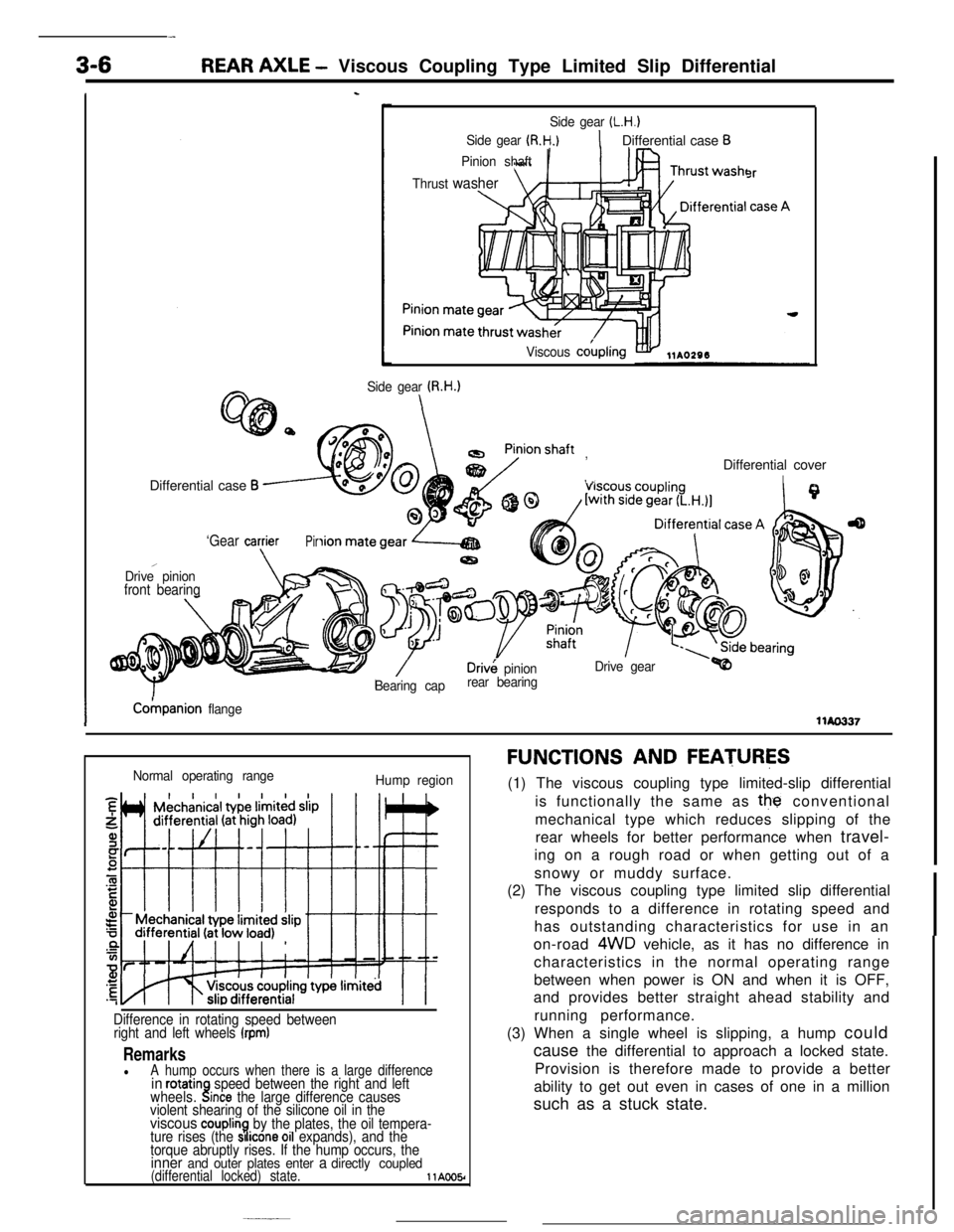
3-6REAR AXLE - Viscous Coupling Type Limited Slip Differential
Is
Side gear (L.H.)
Side gear (R.H.)1Differential case B
Pinion shaft
Thrust
washer
Viscous cokpling
3r
Side gear U3.H.)Differential case
B
, ,,Differential cover
I
‘Gear cagierPir
,Drive pinionfront bearing
Driv& pinionDrive gear
Bearing caprear bearing
ICokpanion flangellAo337
Normal operating range
Hump region
Difference in rotating speed between
right and left wheels (rpm)
RemarkslA hump occurs when there is a large differencein rotatinwheels..!speed between the right and leftlnce the large difference causes
violent shearing of the silicone oil in the
viscous couplin7.by the plates, the oil tempera-
ture rises (the SI Icone 011 expands), and the
torque abruptly rises. If the hump occurs, the
inner and outer plates enter a directly coupled(differential locked) state.llAOO5r
FUNCTIONS AND FEATURES(1) The viscous coupling type limited-slip differential
is functionally the same as
the conventional
mechanical type which reduces slipping of the
rear wheels for better performance when travel-
ing on a rough road or when getting out of a
snowy or muddy surface.
(2) The viscous coupling type limited slip differential
responds to a difference in rotating speed and
has outstanding characteristics for use in an
on-road
4WD vehicle, as it has no difference in
characteristics in the normal operating range
between when power is ON and when it is OFF,
and provides better straight ahead stability and
running performance.
(3) When a single wheel is slipping, a hump could
cause the differential to approach a locked state.
Provision is therefore made to provide a better
ability to get out even in cases of one in a million
such as a stuck state.